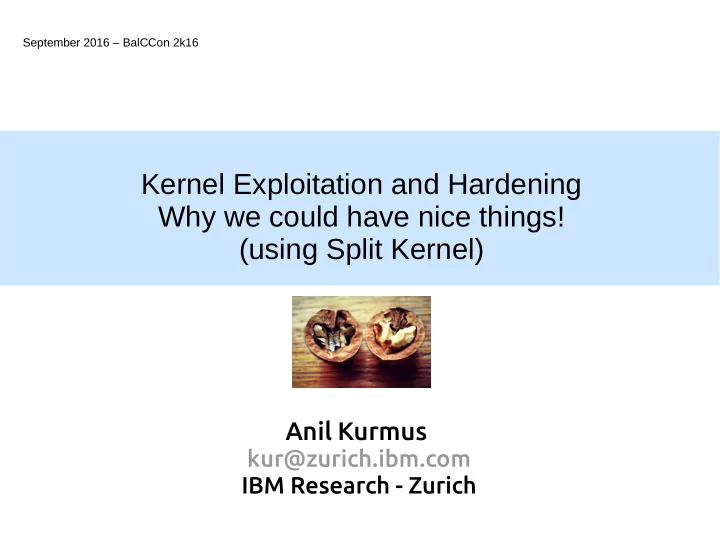

September 2016 – BalCCon 2k16 Kernel Exploitation and Hardening Why we could have nice things! (using Split Kernel) Anil Kurmus kur@zurich.ibm.com IBM Research - Zurich
Outline 1. Background Hardening Kernel Vulnerabilities Kernel Hardening 2. Split Kernel Overview Design Implementation Evaluation 2
A Program F(A,B): ← C A+B ← C C*C RET C 3
A Hardened Program F(A,B): ← C A+B Are we doing OK? ← C C*C Are we doing OK? RET C 4
What Makes A Good Hardening Feature? Asking the right “are we doing OK” question: ● Mitigates many likely vulnerabilities (security) ● Taking few resources to answer (performance) ● Retrofitting and configuration is easy (usability) ● Not breaking the program (correctness) 5
Hardening Feature Examples ● SSP, Heap hardening, Format hardening, ... ● CFI, CPI, SafeStack, Softbound+CETS, ... ● All mitigate some vulnerabilities ● All have some performance overhead Is hardening worth it? 6
Is Hardening worth it? 7
Is Hardening worth it? Easy-to-answer cases first? 8
A wall clock 9
Although... The Great Seal Bug 10
An IoT Wall Clock 11
Let's recap Cases that require hardening, cases that don't ● Hard to tell at the development phase ● Better if configurable during deployment Often a security vs. performance trade-off 12
Kernel Vulnerabilities ● A long standing issue... ● USAF Study [Anderson 1972] ● … relevant to this day in practice ● Windows kernel TrueType Font parsing (Duqu) ● iOS jailbreaks (e.g., PEGASUS recently) ● Linux SCTP remote exploit (sgrakkyu) ● And many more! 13
Stack infoleak 14
Kernel stack clearance ● Zeroing the kernel stack at each syscall (PAX STACKLEAK) ● Can be expensive, does not prevent all vulnerabilities ● Zeroing after each stack allocation ● Even more expensive, but mitigates all stack missing initialization vulnerabilities ● Do we always have to pay this cost? 15
Example: OpenSSH ● The OpenSSH daemon is privilege separated [Provos et al., Sec'03] ● The main daemon runs as root ● A sandboxed process handles session establishment ● An attacker gaining code execution in the sandboxed process can escape via a kernel exploit → kernel hardening is beneficial ● An attacker gaining code execution in the main process has full access → kernel hardening causes unnecessary overhead 16
The best of both worlds What if one could select kernel hardening at runtime, at no cost, in a granular way? 17
Split Kernel Kurmus & Zippel, ACM CCS'14 http://static.securegoose.org/papers/ccs14.pdf 18
Overview ● Build kernel with and without hardening ● Chose at run-time whether to run in hardened mode ● Shared data enables switching safely between the two sets of kernel functions 19
Two modes, One kernel ● If compromised in any of the two modes, compromised in both ● But: the kernel is less likely to be compromised in split- hardened mode 20
Design goals ● No split-base overhead → minimal changes to split-base code ● No control flow from split-hardened to split-base → need to instrument the code ● Run-time configurability → binding processes, users, interrupts, ... ● Maintainability → limit changes to the Linux kernel 21
Example: OpenSSH + Split Kernel Goal: no overhead 22
Low overhead split-base do_read: … %rax = @vfs_read call *%rax sys_read: … call do_read compare read() branch 23 Low split-base overhead by design
Split-hardened mode 24
Binding sandboxed sshd to split-hardened mode ● Execute during boot scripts: id -u sshd >> /sys/kernel/split/hdn_uid_list ● No application source changes ● Similar: binding individual processes, interrupts 25
Split-hardened mode Goal: remain in hardened mode 26
Remaining in hardened mode ● Idea: instrument every base function ● Problem: creates overhead in split-base mode ● Better to instrument at the call source ● Split kernel modifies or instruments split- hardened function calls ● Direct calls: modified at build-time ● Indirect calls: statically instrumented to use alternative function address 27
Example: OpenSSH @vfs_read__hdn vfs_read: … do_read __hdn : … %rax = @vfs_read %rax = *(%rax-8) call *%rax sys_read __hdn : … call do_read __hdn read() Efficient indirect call instrumentation 28
Split Builds 29
Implementation highlights ● Split builds use ELF symbol weakening to ensure data sharing ● Kernel hardening mechanisms implemented: ● Kernel stack exhaustion prevention ● Kernel stack clearance ● Kernel function pointer protection ● Code segregation to prevent split-base performance regressions from spatial locality ● x86-64 and MIPS32 (OpenWrt) port ● Full loadable kernel module support 30
Implementation 31
Demo 32
Evaluation 33
Micro benchmarks 34
Macro benchmarks: OpenSSH ● Kernel performance insensitive workloads ● “Opportunistic hardening” possible ● Split-hardened binding 1 is much faster ● Reason: 1K syscalls vs. 100K syscalls, network polling thread ● Choosing between binding 1 and 2 (w/ interrupt binding) ● Depending on perceived attack surface and performance gain 35
Conclusion 36
Split Kernel may be used... ● By sysadmins, developers, packagers: ● to tailor the kernel to security and performance needs. ● By kernel maintainers: ● to cut down on “performance vs. security” debates. ● By researchers and kernel developers: ● to argue that a powerful, yet slow, kernel hardening mechanism is practical 37
We could have nice things! Contact: kur@zurich.ibm.com 38
IBM Research - Zurich 39
Recommend
More recommend